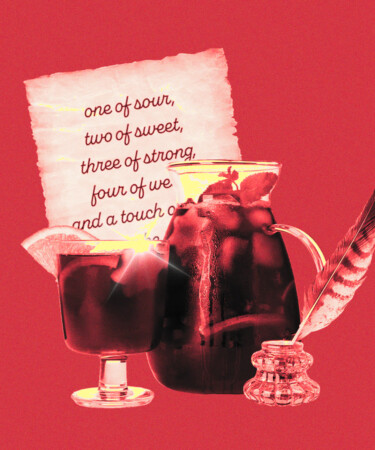When holiday party season rolls around, nothing makes a better low-lift, crowd-pleasing beverage than a big ol’ bowl of booze. Some reading this might already be seasoned punch professionals with a few yuletide recipes under their belts, while it may be others’ first time on party punch duty. Either way, it’s easy to do a big-batch beverage a disservice by messing up its ratios: Too many sweet ingredients and you’ve got fruit punch on your hands; too much booze and the party will escalate far quicker than it should; and too many bubbles will result in an overly diluted, hard- seltzer hybrid.
That said, it’s just as simple to produce a perfect punch, and we’re here to provide you with the centuries-old, bartender-approved template to help you do so. Even better, this workhorse of a method is easy to riff on to impress guests for years to come.
A Condensed History of “Punch”
The first-ever documented mention of an alcoholic “punch” appeared in 1632, when one of the English East India Company’s men at arms wrote to a fellow merchant who was about to set sail to Bengal. According to “The Oxford Companion to Spirits and Cocktails,” he wrote, “I hop you will keep good house, and drincke punch by no allowanc.” Based on this anecdote and the fact that concurrent Indian texts made no mention of punch, it is presumed that punches were invented by British occupants in India using local ingredients.
Early iterations of punch were described as a blend of palm arrack, lime, sugar, rose water, and spices served in a large communal bowl. From India, punches made their way over to the Caribbean in the late 1600s via British trade routes. It was there — specifically, Barbados — where the now famous sing-a-long guide for the ratios to use when building a successful punch was coined:
“One of sour, two of sweet, three of strong, four of weak, and a touch of spice to make it nice.”
Given how broad of a template that is, we’ve put together a few suggestions for putting it to use in your holiday punch this winter.
The Formula
This method still applies to the modern versions of punch, which the “Oxford Companion” describes as “a mixture of spirits, citrus juice, sugar, and water, often with the addition of spices.” There are no concrete rules when it comes to which strong, weak, sour, and sweet components you choose to incorporate in your punch, but there are a few options that offer great versatility and weave seamlessly into countless punch variants.
One of sour
This is arguably the easiest piece to tackle. Any citrus juice will do, but we recommend sticking to the more sour options to balance out whatever else is going in the mix. Lemon, lime, and grapefruit juice are your safest bets here. Lime and grapefruit pair well with aged rum and light spirits, while lemon generally finds good company with dark spirits like brandy, bourbon, and rye.
Two of sweet
The options for the sweet element are practically endless. If opting for rum or tequila, we suggest any combination of island-adjacent fruit juices, whether pineapple, mango, or guava, or even coconut cream. If taking the tropical route isn’t your speed, go with something more neutral like simple syrup or honey syrup, which pair with just about any spirit. For those who have the time and are feeling adventurous, try making an herb-infused sweetener like thyme simple syrup. It’s cheap, easy, and will be sure to wow your guests. That said, if you’re looking for the path of least resistance, we remind you that cranberry-lime seltzer is always a grocery run away.
Three of strong
When it comes to the booze, the liquor cabinet is your oyster — any spirit is fair game. For winter weather, people tend to gravitate toward dark spirits like aged rum, brandy, and whiskey, but don’t shy away from clear spirits, either. Gin or vodka both make for a great, easy-to-blend base. And if you can’t decide on one, try a blend. It may sound unorthodox, but adding a splash of mezcal to a rum punch can take the mix to the next level with a touch of smoke and minerality.
Four of weak
Admittedly the “weak” is the most straightforward part of the old punch template: Consider club soda, water, or even just ice. You won’t want to water the punch bowl down too much, but some dilution is necessary to weave everything together. If those three options don’t entice you, tone down the ratios to two parts ice or water, and top off each individual serving with Champagne. Something bubbly is always a nice touch around the holidays, but be mindful that subbing in some sparkling will pack a bigger wallop of alcohol.
A touch of spice to make it nice
Last but not least is the finishing touch. Feel free to get creative here, but you can’t go wrong with traditional baking spices and “Christmas spices” like ginger, clove, cinnamon, and nutmeg — and freshly grated is always best. These ingredients are especially enticing when you subvert the expectation of a cold punch: Try making something akin to a batched Hot Toddy and throw a sachet of mulling spices into the mix. Regardless of serving temp, spices can double as a garnish, too. Add some cinnamon sticks or a few dehydrated orange wheels for visual flair. Above all, have fun with it. Good luck, and happy punch-making to you and yours.
*Image retrieved from smuay via stock.adobe.com
